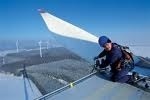News Release from Vestas
Wind Industry Profile of
06/29/2010
Denmark - Vestas: Business on the rise?
 Vestas Wind
Vestas Wind
That's great for the planet-wind energy is part of the solution to the climate crisis. It hasn't been good for the company's bottom line, at least not lately. But Vestas sees better days ahead.
Vestas, as you may know, is a global company, based in Denmark, and the world's largest manufacturer of wind turbines. (It installed 5,581 MW of capacity in 2009, which represents 12.% of the global market.) Two of its biggest wind industry competitors-General Electric and Siemens-also make plants and equipment to burn coal and natural gas, and they are diversified beyond the energy business as well. They aren't as "green," at least in the environmental sense of the word, but they don't depend on wind.
Vestas does, and so the company has taken a hit because of a global slowdown in the wind industry, driven in part by the 2009 recession and credit crunch. Low natural gas prices are a problem for wind-turbine manufacturers, because utilities build gas-fired plants instead. So are the continuing uncertainties of energy policy in the U.S.-an investment tax credit that is crucial to wind projects is set to expire this year. Another worry for the biggest players: China, a huge market, has become intensely competitive, with dozens of local competitors entering the fray.
As a result, in the first quarter of 2010, Vestas took a hit. The company booked revenues of 755 million Euros, down from 1,105 mEUR in 2009. It reported a loss of 96 mEUR, which compares with 76 mEUR in EBIT during Q1 of 2009. The stock is down by more than 20% in the last year.
Wyrsch says things are looking better for the year ahead. "We see orders picking up again," she says. The company operates three factories in Colorado, and it plans to open a fourth this year. It has estimated that its U.S. business will grow by 25% annually between now and 2014, although given the absence of carbon regulation, such projections should probably be viewed with some skepticism.
But wind isn't cost competitive yet, and so Wyrsch and her boss, Vestas CEO Ditlev Engel, had come to Washington to ask Uncle Sam for a helping hand. With the rest of the industry, Vestas is asking the Congress to extend two subsidies that are crucial to the industry: Wind project developers can chose to take a 30% investment tax credit for facilities that begin construction an ill-defined term by the end of 2010 or they an elect to take a production tax credit of 2.1 cents per kilowatt hour under legislation that expires in 2012. The wind industry is also pushing a national renewable electricity standard, which would require a portion of the nation's electric to come from renewable energy by a date certain 25% by 2025, some have said.
Why should taxpayers support the subsidies? First, Wyrsch says, because we as a nation "don't want to become dependent on any one source of energy. We need a variety of sources of power in our portfolio." Wind can not only replace coal and gas, but it has the potential to become a substitute for oil in the long run, if the U.S. can electrify a substantial part of its cars.
Second, she says, the oil and gas industries have enjoyed federal support for decades, and so wind and solar need a boost to get to parity. "We need to be sure that this industry has the opportunity to get to a level playing field," she says. "We're not nearly as highly subsidized as some in the oil and gas industry."
Vestas, she notes, is also creating jobs. It employs about 1,800 people in the U.S., with about 350 at corporate headquarters in Portland, another 800 in Colorado, about 100 engineers in Houston (where they draw up ex-NASA people to do R&D) and others who service existing installations spread around the country. One of its suppliers, a company called Hexcel, also has opened a small plant in Colorado.
Vestas sells its wind turbines to utilities including Duke, Sempra, Next Era and Puget Sound Energy. For the wind industry to really take off, those utilities and the government will have to provide additional support. For one thing, utilities need to develop ways to store energy. Vestas is doing its part it recently announced a research project intended to develop a wind turbine with built-in storage. For another, utilities and the government need to develop transmission lines to deliver wind from rural regions where the wind blows steadily, such as Iowa and the Dakotas, to population centers.
Despite the industry's recent woes, Vestas - which has began producing wind turbines in 1979 - has been an excellent long-term investment. During the past five years, a period during with the S&P500 has been flat, Vestas' shares, which are traded on the NASDAQ OMX Copenhagen (formerly the Copenhagen Stock Exchange, have nearly tripled in price.
For more information please contact Trevor Sievert at ts@windfair.net
Vestas, as you may know, is a global company, based in Denmark, and the world's largest manufacturer of wind turbines. (It installed 5,581 MW of capacity in 2009, which represents 12.% of the global market.) Two of its biggest wind industry competitors-General Electric and Siemens-also make plants and equipment to burn coal and natural gas, and they are diversified beyond the energy business as well. They aren't as "green," at least in the environmental sense of the word, but they don't depend on wind.
Vestas does, and so the company has taken a hit because of a global slowdown in the wind industry, driven in part by the 2009 recession and credit crunch. Low natural gas prices are a problem for wind-turbine manufacturers, because utilities build gas-fired plants instead. So are the continuing uncertainties of energy policy in the U.S.-an investment tax credit that is crucial to wind projects is set to expire this year. Another worry for the biggest players: China, a huge market, has become intensely competitive, with dozens of local competitors entering the fray.
As a result, in the first quarter of 2010, Vestas took a hit. The company booked revenues of 755 million Euros, down from 1,105 mEUR in 2009. It reported a loss of 96 mEUR, which compares with 76 mEUR in EBIT during Q1 of 2009. The stock is down by more than 20% in the last year.
Wyrsch says things are looking better for the year ahead. "We see orders picking up again," she says. The company operates three factories in Colorado, and it plans to open a fourth this year. It has estimated that its U.S. business will grow by 25% annually between now and 2014, although given the absence of carbon regulation, such projections should probably be viewed with some skepticism.
But wind isn't cost competitive yet, and so Wyrsch and her boss, Vestas CEO Ditlev Engel, had come to Washington to ask Uncle Sam for a helping hand. With the rest of the industry, Vestas is asking the Congress to extend two subsidies that are crucial to the industry: Wind project developers can chose to take a 30% investment tax credit for facilities that begin construction an ill-defined term by the end of 2010 or they an elect to take a production tax credit of 2.1 cents per kilowatt hour under legislation that expires in 2012. The wind industry is also pushing a national renewable electricity standard, which would require a portion of the nation's electric to come from renewable energy by a date certain 25% by 2025, some have said.
Why should taxpayers support the subsidies? First, Wyrsch says, because we as a nation "don't want to become dependent on any one source of energy. We need a variety of sources of power in our portfolio." Wind can not only replace coal and gas, but it has the potential to become a substitute for oil in the long run, if the U.S. can electrify a substantial part of its cars.
Second, she says, the oil and gas industries have enjoyed federal support for decades, and so wind and solar need a boost to get to parity. "We need to be sure that this industry has the opportunity to get to a level playing field," she says. "We're not nearly as highly subsidized as some in the oil and gas industry."
Vestas, she notes, is also creating jobs. It employs about 1,800 people in the U.S., with about 350 at corporate headquarters in Portland, another 800 in Colorado, about 100 engineers in Houston (where they draw up ex-NASA people to do R&D) and others who service existing installations spread around the country. One of its suppliers, a company called Hexcel, also has opened a small plant in Colorado.
Vestas sells its wind turbines to utilities including Duke, Sempra, Next Era and Puget Sound Energy. For the wind industry to really take off, those utilities and the government will have to provide additional support. For one thing, utilities need to develop ways to store energy. Vestas is doing its part it recently announced a research project intended to develop a wind turbine with built-in storage. For another, utilities and the government need to develop transmission lines to deliver wind from rural regions where the wind blows steadily, such as Iowa and the Dakotas, to population centers.
Despite the industry's recent woes, Vestas - which has began producing wind turbines in 1979 - has been an excellent long-term investment. During the past five years, a period during with the S&P500 has been flat, Vestas' shares, which are traded on the NASDAQ OMX Copenhagen (formerly the Copenhagen Stock Exchange, have nearly tripled in price.
For more information please contact Trevor Sievert at ts@windfair.net
- Source:
- Vestas
- Author:
- Posted by Trevor Sievert, Online Editorial Journalist
- Email:
- vestas-centraleurope@vestas.com
- Link:
- www.vestas.com/...
- Keywords:
- Wind energy, wind power, wind turbine, wind mill, offshore, onshore, wind farm, renewable energy











